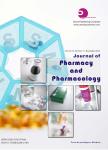Antibacterial Activity of Silver Nanoparticles Using Salvia officinalis Extract on Some Pathogenic Bacteria
作者机构:Department of Molecular and Medical BiotechnologyCollege of BiotechnologyAl-Nahrain UniversityBaghdadIraq
出 版 物:《Journal of Pharmacy and Pharmacology》 (药剂与药理学(英文版))
年 卷 期:2019年第7卷第5期
页 面:237-248页
学科分类:10[医学]
主 题:Salvia officinalis sliver nitrate antibacterial minimum inhibitory concentrations biofilm
摘 要:This study included evaluation for the effects of green synthetic nanoparticles of Salvia officinalis aqueous leaf extract loaded with silver nitrate on antibacterial activity. Green synthetic nanoparticles were synthesized by mixing the plant extract with different AgNO3 concentrations (1 mM, 1.5 mM, 1.75 mM, and 2 Mm) then they were detected by color changing and UV visible spectroscopy, which gave indication for the creation of silver nanoparticles. A characteristic and definite surface plasmon resonance (SPR) band for silver nanoparticles was obtained at around 433 nm. The SPR peak of silver nanoparticles extreme peak intensity was obtained at 1.75 mM of AgNO3. Atomic Force Microscopy analysis was used to characterize silver nanoparticles which declared that the shape of green synthetic nanoparticles had different average size depending on sliver concentrations. Since it was observed that the shape and size of green synthetic nanoparticles were concentrations dependent (89.69 nm, 80.94 nm, 76.98 nm and 60.28 nm) respectively for AgNO3 concentrations tested (1 mM, 1.5 mM, 1.75 mM and 2 mM). The antibacterial activity of green synthetic sliver nanoparticles was studied for all G+ve and G-ve selected isolates (Staphylococcus aureus, Staphylococcus heamolytics, Streptococcus pnemoniae, Enterococcus faecalis) and others G-ve bacterial isolates (Escherichi coli, Klebsiella pneumoniae, Proteus vulgaris, Pseudomonas aeruginosa) and the result showed that different green synthetic nanoparticles concentrations (1, 1.5, 1.75, 2 mM) have the ability to inhibit all bacterial isolates with varying zones of inhibition higher than the inhibition observed by ready to use sliver nanoparticles. Minimum inhibitory concentrations (MIC) of green synthetic nanoparticles were obtained in concentration of (31, 27, 23 and 16 μm/mL) for G+ve (S. auerus) and (187, 125, 125, 109 μm/mL) for G-ve (E. coli) at (1, 1.5, 1.75, 2 mM) respectively. The activity of green synthetic sliver nanopartic



